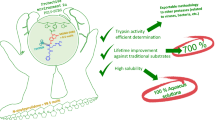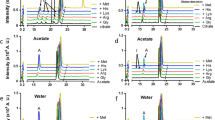Abstract
The effects of neighboring residues and formulation variables on tyrosine oxidation were investigated in model dipeptides (glysyl tyrosine, N-acetyl tyrosine, glutamyl tyrosine, and tyrosyl arginine) and tripeptide (lysyl tyrosyl lysine). The tyrosyl peptides were oxidized by light under alkaline conditions by a zero-order reaction. The rate of the photoreaction was dependent on tyrosyl pKa, which was perturbed by the presence of neighboring charged amino acid residues. The strength of light exposure, oxygen headspace, and the presence of cationic surfactant, cetyltrimethylammonia chloride had a significant effect on the kinetics of tyrosyl photooxidation. Tyrosine and model tyrosyl peptides were also oxidized by hydrogen peroxide/metal ions at neutral pH. Metal-catalyzed oxidation followed first-order kinetics. Adjacent negatively charged amino acids accelerated tyrosine oxidation owing to affinity of the negative charges to metalions, whereas positively charged amino acid residues disfavored the reaction. The oxidation of tyrosine in peptides was greatly affected by the presence of adjacent charged residues, and the extent of the effect depended on the solution environment.
Similar content being viewed by others
References
Pharmaceutical Manufacturers Association.Survey Report. Washington, DC: PhRMA; 1998–2002.
Wang W. Instability, stabilization, and formulation of liquid protein pharmaceuticals.Int J Pharm. 1999;185:129–188.
Penner MH, Yamasaki RB, Osuga DT, Babin DR, Meares CF, Feeney RE. Comparative oxidations of tyrosines and methionines in transferrins: human serum transferring, human lactotransferrin, and chicken ovotransferrin.Arch Biochem Biophys. 1983;225:740–747.
Stadtman ER. Oxidation of free amino acids and amino acid residues in proteins by radiolysis and by metal-catalyzed reactions.Annu Rev Biochem. 1993;62:797–821.
Li S, Schoneich C, Borchardt RT. Chemical instability of protein pharmaceuticals: mechanisms of oxidation and strategies for stabilization.Biotechnol Bioeng. 1995;48:490–500.
Wang YJ, Hanson MA. Parenteral formulations of proteins and peptides: stability and stabilizers. In:Technical Report 10. Bethesda, MD: Parenteral Drug Association; 1998:3–26.
Kerwin BA Jr, Remmele RL Jr. Protect from light: photodegradation and protein biologics.J Pharm Sci. 2007;96:1468–1479.
Creed D. The photophysics and photochemistry of the near-UV absorbing amino acids. II. Tyrosine and its simple derivatives.Photochem Photobiol. 1984;39:563–575.
Joshi P, Carraro C, Pathak M. Involvement of reactive oxygen species in the oxidation of tyrosine and dopa to melanin and in skin tanning.Biochem Biophys Res Commun. 1987;142:265–274.
Huggins TG, Wells-Knecht MC, Detorie NA, Baynes JW, Thorpe SR. Formation of o-tyrosine and dityrosine in protein during radiolytic and metal-catalyzed oxidation.J Biol Chem. 1993;268:12341–12347.
Aeschbach R, Amado R, Neukom H. Formation of dityrosine cross-links in protein by oxidation of tyrosine residues.Biochim Biophys Acta. 1976;439:292–301.
Bertolotti SG, Garcia NA. Effect of the peptide bond on the singlet-molecular-oxygen-mediated sensitized photo-oxidation of tyrosine and tryptophan dipeptides.J Photochem Photobiol. 1991;10:57–70.
Nema S, Washkuhn RJ, Beussink DR. Photostability testing: an overview.Pharm Technol. 1996;19:170–185.
Fransson J, Florin-Robertsson E, Axelsson K, Nyhlen C. Oxidation of human insulin-like growth factor I in formulation studies: kinetics of methionine oxidation in aqueous solution and in solid state.Pharm Res. 1996;13:1252–1257.
Gu L, Chiang H-S, Johnson D. Light degradation of ketorolac tromethamine.Int J Pharm. 1988;41:105–113.
Mendenhall D. Stability of parenterals.Drug Dev Ind Pharm. 1984;10:1297–1342.
Tanford C, Hauenstein JD, Rands DG. Phenolic hydroxyl ionization in proteins. II. Ribonuclease.J Am Chem Soc. 1955;77:6409–6413.
Weil L. On the mechanism of the photo-oxidation of amino acids sensitized by methylene blue.Arch Biochim Biophys. 1965;110:57–68.
Scotchler AB, Robinson AB. Deamidation of glutaminyl residues: dependence on pH, temperature and ionic strength.Anal Biochem. 1974;59:319–322.
Flatmark T. On the heterogeneity of beef heart cytochrome C. III. A kinetic study of the nonenzymatic deamidation of the main subfraction.Acta Chem Scand A. 1966;20:1487–1496.
Donbrow M, Azaz E, Pillersdorf A. Autoxidation of polysorbates.J Pharm Sci. 1978;67:1676–1681.
Hora MS, Rana RK, Wilcox CL, et al. Development of a lyophilized formulation of interleukin-2.Dev Biol Stand. 1991;74:295–306.
Kumar V, Kalonia D. Removal of peroxides of polyethylene glycols by vacuum drying: implications in the stability of biotech and pharmaceutical formulations.AAPS PharmSciTech. 2006;7:E62.
Steinhardt J, Stocker N. Effects of high pH and sodium dodecyl sulfate on the hidden tyrosines of human serum albumin.Biochemistry. 1973;12:1789–1797.
Blount BC, Duncan MW. Trace quantification of oxidative damage products, meta- and ortho-tyrosine, in biological samples by gas chromatography-electron capture negative ionization mass spectrometry.Anal Biochem. 1997;244:270–276.
Zhao F, Ghezzo-Schoneich E, Aced G, Hong J, Milby T, Schoneich C. Metal-catalyzed oxidation of histidine in human growth hormone.J Biol Chem. 1997;272:9019–9029.
Frank MJ, Johnson JB, Rubin SH. Spectrophotometeric determination of sodium nitroprusside and its photodegradation products.J Pharm Sci. 1976;65:44–48.
Chatterji DC, Gallelli JF. Thermal and photolytic decomposition of methotrexate in aqueous solutions.J Pharm Sci. 1978;67:526–531.
Jamil N, Afrozrizvi H, Ahmed I, Ejazbeg A. Studies on the photostability of reserpine in parenterals solutions.Pharmazie. 1983;38:467–469.
Feitelson J, Havon E, Treinin A. Photoionization of phenols in water: effects of light intensity, oxygen, pH, and temperature.J Am Chem Soc. 1973;95:1025–1029.
Shimizu O. Excited states in photodimerization of aqueous tyrosine at room temperature.Photochem Photobiol. 1973;18:25–133.
Matheson IBC, Lee J. Chemical reaction rates of amino acids with singlet oxygen.Photochem Photobiol. 1979;29:879–881.
Galand D Jr, Zigler JS Jr, Kinoshita J. Structural changes in bovine lens crystalline induced by ascorbate, metal, and oxygen.Arch Biochim Biophys. 1986;251:771–776.
Kanazawa H, Fujimoto S, Ohara A. Effect of radical scavengers on the inactivation of papain by ascorbic acid in the presence of cupric ions.Biol Pharm Bull. 1994;17:476–481.
Author information
Authors and Affiliations
Corresponding author
Additional information
Published: December 7, 2007
Rights and permissions
About this article
Cite this article
Zhang, J., Kalonia, D.S. The effect of neighboring amino acid residues and solution environment on the oxidative stability of tyrosine in small peptides. AAPS PharmSciTech 8, 102 (2007). https://doi.org/10.1208/pt0804102
Received:
Revised:
Accepted:
DOI: https://doi.org/10.1208/pt0804102




